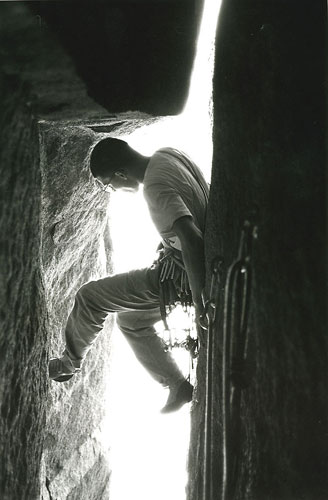
Yosemite's classic pitch "The Narrows" on the North Face of Sentinel Rock
swallows Ryan Frost, 1996.

Yosemite's classic pitch "The Narrows" on the North Face of Sentinel Rock
swallows Ryan Frost, 1996.
INNSBRUCK, 2002
A long time ago . . .
In a valley far, far away
By Tom Frost
The hope of freedom was kept alive by a small band of Camp 4
rebels.
Led by young Royal Rockwalker, and the shaggy, five-foot
wookie
Chewi-nard . . . The rebels were prepared for offensives . . . On the granite walls of Yosemite.
Yes, in that long-ago time I actually did have the
opportunity to climb with those not-yet-so-famous occupants of Camp 4, Royal
Robbins, Chuck Pratt, Yvon Chouinard and TM Herbert. Each were masters of
style and each of them were leaders of that golden age of Yosemite big wall
climbing. We loved the movement in climbing, the beauty of the creation, the
depth of our companionship, and the discovery of the unknown. It was great!!
Those El Cap climbs we did together changed my life. They changed who I was. I
am grateful for the experiences. It seemed unlikely to me that such adventures
would ever be possible again. But in recent years I have been able to return to
El Capitan, and to those same routes of long ago. To my joy, it was just the
same - great companionship and classic climbing. The only mystery is why they
have become so much harder.
The golden age was all about style. We were not confronted by
concerns about regulations, over-use, worn out routes, topos, or public opinion.
We were very mindful of the example of our pioneer predecessors, but we felt
free to follow our own path and make our own choices. El Cap in the 1960's was a blank page waiting to be written
upon. But life always has two opposing views - and so it was in the beginning of
the golden age. One view emerged which supported style and preservation. The
motto was, "leave no trace". These proponents believed, "It isn't
getting to the top that counts. It's the way you do it". This mentality
shaped character. Climbing became an internal game. It was based on personal responsibility. The opposing view was not about style or responsibility. Its
foundation was entitlement. These climbers were not concerned about how they
climbed, nor about the environment, nor about future climbers. Getting to the
top was the goal. Theirs was an external game.
In America, the clean climbing revolution of the 1970's
replaced the use of pitons with nuts, runners, and later spring-loaded cams.
This switch to clean climbing saved our cracks. In the 1980's the arrival of sport climbing opened climbing
on previously unprotectable walls with the use of artificial protection. This
type of climbing inflamed the already existing conflict among climbers between
"leave no trace" and "do what you want". The rise of gym climbing in the 1990's popularized the sport.
Climbing no longer is an obscure sport done by a few, with makeshift equipment,
in remote places. In 2002 climbing is big business, highly visible, extremely
popular, diversified, unmanaged, highly specialized, and highly scrutinized. We
are here today to address these issues. The styles of rock climbing fall into 5 basic categories.
They are as follows: 1. Traditional Climbing: originated in an atmosphere of environmental respect it employs natural protection it endeavors to leave no trace 2. Clean Climbing: recognizes the damaging effect of repeated piton usage it employs nuts, runners, and spring-loaded cams for
protection 3. Sport Climbing: opens climbing on previously unprotectable rock it employs artificial protection since there are no natural limiting factors to where
bolts and sport routes can be placed, self-management and/or control and
regulations become an issue 4. Plaisir Climbing (if I understand it correctly): is the product, or result of, unrestricted, un-managed,
uncontrolled, unregulated sport climbing it changes traditional routes 5. Gym Climbing: enables a social and athletic experience in an
artificial environment it has become a modern substitute for mentoring and
the opportunity to learn from nature We now live in a mobile, ravenous information age. This has
afforded many with much, and greatly shrunk the world. It has created a
subculture of wanna-be's, seeking instant gratification with little or no
accountability. This group has invaded climbing. They act like unmanaged youth:
I want it. I take it. I walk away from it. And there are no consequences.
One must always remember that - selfishness, - entitlement, -
lack of self management, - mis-education, - and disrespect are the culprits.
These 5 attitudes are the enemy, not the people. I am reminded of the fact that
nature gives more than it takes - but man takes more than he gives until he
becomes aware. Together we can work to increase man's awareness.
To increase awareness we must become conversant with:
The Problem The Cause The Solution The Implementation
The skills we need for this task, both during this
conference, and after the "Tyrol Declaration" is completed and goes
forth to the world, are:
Identification Listening Communication Understanding Education Negotiation Respect
The groups we need to reach are these:
All climbers of every type Land managers Governments Outdoor organizations Adventure-sport businesses Environmentalists Crafting a document that outlines freedom governed by
boundaries has always been a challenge. Yet, I believe this convention will find
its way through the issues and present a set of guidelines that will stand as a
firm foundation and ensure the continuation of climbing for generations.
This address was delivered at the International Congress,
"Future of Mountain Sports," a